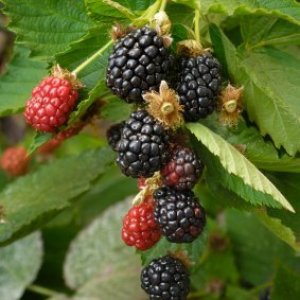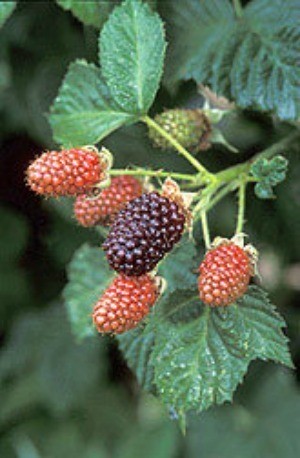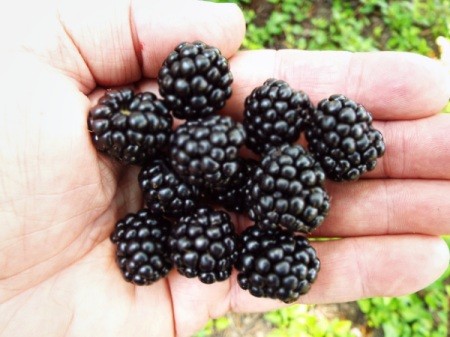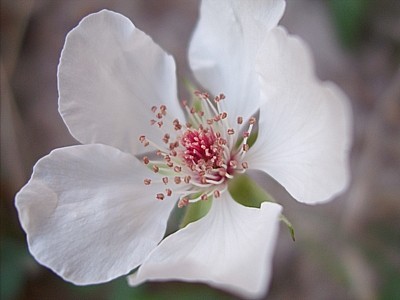
This page contains the following solutions.

I'm doing my best to get fellow members to look into growing berries and dwarf fruit trees in small, sunny spaces about their homes. Eating fruits and berries you have grown has very satisfying rewards. The Europeans are, and have been, way ahead of us in utilizing any free space about the home to grow fruits and vegetables.
Let's talk blackberries. I bought four $10.00 plants that were marked down to $3.00 each. There are several different types of blackberries. I won't go into the differences, here. I will say that the type I bought bears fruit on the second year's growth.
If you buy such a plant with all new growth, you will not get any berries the first year. This new growth will stay on the plant til next year. Then it will bear berries. While this, now, second year's growth is bearing berries, new growth will arise from the base of the plant. After the berry bearing canes stop producing, they begin to die down and eventually die all together. The new growth will survive the winter and become next year's canes to bear berries.
What should one do with the bearing canes when they begin to die back? You can cut them back to the ground and discard them. But don't be so hasty to do that. Cuttings can be taken from these canes as soon as the berries are harvested. They are easily rooted. You could easily get 10 new plants from these 'dying' canes. (You also can easily root tender new growth, but that's another post).
After your initial purchase, all your plants can be free. A little fertilizer and bird netting will be about your only expenses. Water? Yes. Count that as an expense if you like. Blackberries like lots of water.
With the two varieties I bought being 'erect' rather than 'spreading', the full grown berry bearing plants have a diameter that hardly exceeds that of the 5 gallon buckets they are planted in. These winter hardy plants stay outside over winter and need no protection.
Decision making? Well, in this case, do I make wine with these big bad boys, or do I make a cobbler? Actually, I won't do either. Next year, my plants will be larger, more established and will bear more fruit. For now, I will periodically traipse to the back yard, pick a handful of berries and simply indulge.
I do plan to puree a few and have them over vanilla ice cream. Yes!
Are you convinced, yet?
This is just a warning to those of you who are interested in planting blackberries. Choose your site carefully.
Here are the questions asked by community members. Read on to see the answers provided by the ThriftyFun community.
If I bush hog my tame blackberries down this fall, will they come back next spring?
Yes, and they will come back thicker.
From my experience, careful pruning can even increase crops....more blackberries! YUM!!!
If the plants are healthy, they should come back next year. But don't expect berries the first year after cutting them to the ground.
The first year's canes are called primocanes. They do not bear fruit. The next year, the primocanes become floricanes, they produce flowers, then fruit. Then they die. This is Nature's way of pruning the plant.
If there is a reason to prune the primocanes, I guess it's OK. I would not prune the floricanes. You would be pruning away fruit bearing cane, especially the tips.
i agree about maybe taking two years to bear fruit after cutting back severely. There is some controversy about this but it seems most agree that it may take two years for berries, so you will need to have a year to get the canes back.
Maybe bush-hog half and prune the other half so you may have berries next year?
Maybe I should have consulted my notes on blackberries before posting because I wasn't aware of controversy. Unless I'm mistaken, there are plants that will bear a small crop of fruit on the first year's canes, late in the season.
How do I get slips from thornless blackberries?
By Donnie from Boaz, KY
In the spring when the blackberry leaves come out, draw the tip of the cane onto the ground and secure it with a chunk of wire that you have cut to resemble a large hairpin. A piece 7 or eight inches long that has been bent double will do quite nicely. Do this for as many slips as you want in the fall. In the fall cut the new canes free of the old ones and dig them up and replant.be sure to cover with mulch if it gets really cold where you are.
Can anyone tell me the best way to grow blackberries and raspberries in containers? I have wild blackberries all around my back yard, but the wildlife beats me to them!
My zone is 7b.
By Cricket from NC
Check out these photos.
This is a blackberry bloom. Taking these pictures are therapy for me.


Photo Description You're all wrong. It's an Arapaho! It's a blackberry! This blackberry should be in every home garden. If you have space for a 5 gallon bucket, you have room for this berry. It was developed by the University of Arkansas. It is a thornless variety. Pretty high on the brix (sweetness) scale, and a very good bearer. This is my first year to grow them. They're in 5 gallon buckets along side my Apache blackberries. They're all loaded with blooms. Come the 4th of July, I may just have enough berries to try my hand at a cobbler. The least I could do is a blackberry topping for vanilla ice cream. Yes!
It's a cherry!
No. It's a peach!
No. It's an apple.
Optimal sweetness is achieved when the berry is fully ripe. Some berries actually may appear ready to pick when black and shiny, but with some varieties it is when they become less shiny that they are the sweetest. This is a page about picking the ripest blackberries.
If you decide to grow blackberries, be aware that the different varieties have varying levels of sweetness. Picking the berries later in the season will make them sweeter too.